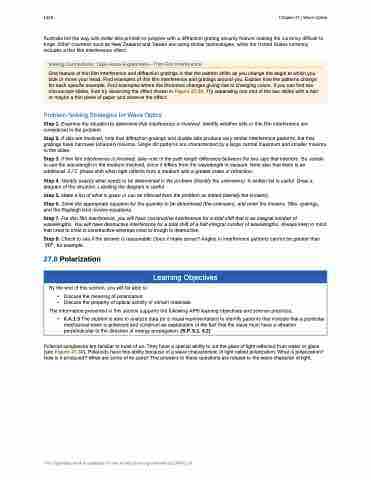Page 1238 - College Physics For AP Courses
P. 1238
1226 Chapter 27 | Wave Optics
Australia led the way with dollar bills printed on polymer with a diffraction grating security feature making the currency difficult to forge. Other countries such as New Zealand and Taiwan are using similar technologies, while the United States currency includes a thin film interference effect.
Problem-Solving Strategies for Wave Optics
Step 1. Examine the situation to determine that interference is involved. Identify whether slits or thin film interference are considered in the problem.
Step 2. If slits are involved, note that diffraction gratings and double slits produce very similar interference patterns, but that gratings have narrower (sharper) maxima. Single slit patterns are characterized by a large central maximum and smaller maxima to the sides.
Step 3. If thin film interference is involved, take note of the path length difference between the two rays that interfere. Be certain to use the wavelength in the medium involved, since it differs from the wavelength in vacuum. Note also that there is an additional � � � phase shift when light reflects from a medium with a greater index of refraction.
Step 4. Identify exactly what needs to be determined in the problem (identify the unknowns). A written list is useful. Draw a diagram of the situation. Labeling the diagram is useful.
Step 5. Make a list of what is given or can be inferred from the problem as stated (identify the knowns).
Step 6. Solve the appropriate equation for the quantity to be determined (the unknown), and enter the knowns. Slits, gratings,
and the Rayleigh limit involve equations.
Step 7. For thin film interference, you will have constructive interference for a total shift that is an integral number of wavelengths. You will have destructive interference for a total shift of a half-integral number of wavelengths. Always keep in mind that crest to crest is constructive whereas crest to trough is destructive.
Step 8. Check to see if the answer is reasonable: Does it make sense? Angles in interference patterns cannot be greater than ��� , for example.
27.8 Polarization
Making Connections: Take-Home Experiment—Thin Film Interference
One feature of thin film interference and diffraction gratings is that the pattern shifts as you change the angle at which you look or move your head. Find examples of thin film interference and gratings around you. Explain how the patterns change for each specific example. Find examples where the thickness changes giving rise to changing colors. If you can find two microscope slides, then try observing the effect shown in Figure 27.34. Try separating one end of the two slides with a hair or maybe a thin piece of paper and observe the effect.
Learning Objectives
By the end of this section, you will be able to:
• Discuss the meaning of polarization.
• Discuss the property of optical activity of certain materials.
The information presented in this section supports the following AP® learning objectives and science practices:
• 6.A.1.3 The student is able to analyze data (or a visual representation) to identify patterns that indicate that a particular mechanical wave is polarized and construct an explanation of the fact that the wave must have a vibration perpendicular to the direction of energy propagation. (S.P. 5.1, 6.2)
Polaroid sunglasses are familiar to most of us. They have a special ability to cut the glare of light reflected from water or glass (see Figure 27.36). Polaroids have this ability because of a wave characteristic of light called polarization. What is polarization? How is it produced? What are some of its uses? The answers to these questions are related to the wave character of light.
This OpenStax book is available for free at http://cnx.org/content/col11844/1.14


